| European rabbit | |
|---|---|

| |
| Scientific classification | |
| Domain: | Eukaryota |
| Kingdom: | Animalia |
| Phylum: | Chordata |
| Class: | Mammalia |
| Order: | Lagomorpha |
| Family: | Leporidae |
| Genus: | Oryctolagus |
| Species: | O. cuniculus[1]
|
| Binomial name | |
| Oryctolagus cuniculus[1] | |

| |
| Range map: Native Introduced
| |
| Synonyms | |
|
Lepus cuniculus Linnaeus, 1758 | |
The European rabbit (Oryctolagus cuniculus) or coney[4] is a species of rabbit native to the Iberian Peninsula (Spain, Portugal and Andorra) and southwestern France.[3] It is the only extant species in the genus Oryctolagus. The European rabbit has faced a population decline in its native range due to myxomatosis, rabbit hemorrhagic disease, overhunting and habitat loss. Outside of its native range, it is known as an invasive species, as it has been introduced to countries on all continents with the exception of Antarctica, often with devastating effects on local biodiversity due to a lack of predators.
The average adult European rabbit is 40 cm (16 in) in length, and can weigh 1.2–2.0 kg (2.6–4.4 lb), though size and weight vary with habitat and diet. Its distinctive ears can measure up to 6.5–7.5 cm (2.6–3.0 in) from the occiput. Due to the European rabbit's history of domestication, selective breeding, and introduction to non-native habitats, feral European rabbits across the world display a wide variety of morphologies.
The European rabbit is well known for digging networks of burrows, called warrens, where it spends most of its time when not feeding. It is a gregarious species, and lives in social groups centered around territorial females. European rabbits in an established social group will rarely stray far from their warren, with female rabbits leaving the warren mainly to establish nests where they will raise their young. Unlike hares (Lepus spp.), rabbits are altricial and are born blind, requiring maternal care until they leave the nest after 18 days.
Much of the modern research into wild rabbit behaviour was carried out in the 1960s by two research centres. One was the naturalist Ronald Lockley, who maintained a number of large enclosures for wild rabbit colonies, with observation facilities at Orielton, in Pembrokeshire, Wales. Apart from publishing a number of scientific papers, he popularised his findings in a book The Private Life of the Rabbit, which is credited by Richard Adams as having played a key role in his gaining "a knowledge of rabbits and their ways" that informed his novel Watership Down. The other group was the Commonwealth Scientific and Industrial Research Organisation (CSIRO) in Australia, where numerous studies of the social behavior of wild rabbits were performed. Since the onset of myxomatosis, and the decline of the significance of the rabbit as an agricultural pest, few large-scale studies have been performed and many aspects of rabbit behaviour are still poorly understood.
- ^ Hoffman & Smith 2005, pp. 205–206
- ^ Cite error: The named reference
Lopez-Martinez1was invoked but never defined (see the help page). - ^ a b Villafuerte & Delibes-Mateos 2020
- ^
